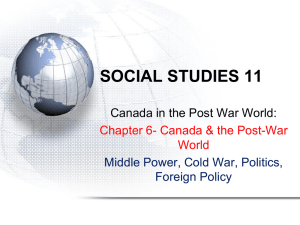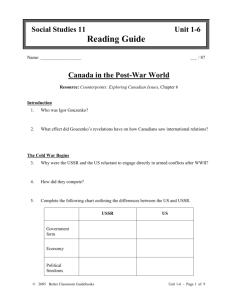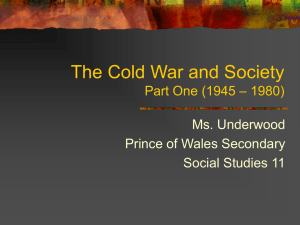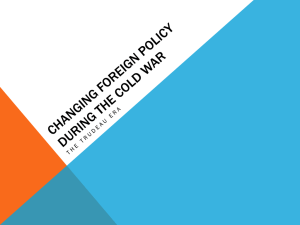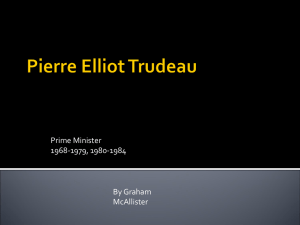Canada in the Post War World
advertisement
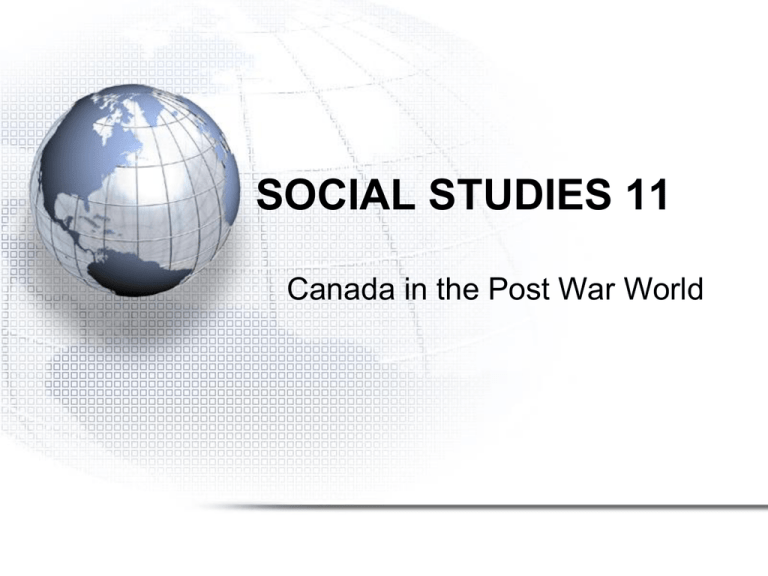
SOCIAL STUDIES 11 Canada in the Post War World Canada in the Post War World • The transition into post-war Canada was smoother after WW II than the transition from WW I. • Past experience had alerted the government to the needs of returning soldiers and the changes required for a successful transition to a peacetime economy. The Gouzenko Affair • Of concern was the admission by a Russian cipher clerk of the existence of a Soviet spy ring in Canada. • Igor Gouzenko’s divulgence of this information resulted in a realization by Canada that it was not removed from international affairs and especially the affairs of its southern neighbour the United States of America. • It would open a new era in foreign affairs. Igor Gouzenko • A cipher clerk for the Soviet Embassy to Canada in Ottawa, Ontario. • He defected on Sept. 5, 1945 with 109 documents on Soviet espionage activities in the West. The Cold War Begins • The U.S.A. and Russia would square off as the world’s superpowers. • As a result of the escalation of nuclear weapons and differing political views, the two nations would confront each other with challenges for control of developing nations. • The superpowers would engage in small scale wars while continually endeavouring to gather secret information through espionage and spy rings. The Ideological Struggle Soviet & Eastern Bloc Nations [“Iron Curtain”] GOAL spread worldwide Communism METHODOLOGIES: US & the Western Democracies GOAL “Containment” of Communism & the eventual collapse of the Communist world. [George Kennan] Espionage [KGB vs. CIA] Arms Race [nuclear escalation] Ideological Competition for the minds and hearts of Third World peoples [Communist govt. & command economy vs. democratic govt. & capitalist economy] “proxy wars” Bi-Polarization of Europe [NATO vs. Warsaw Pact] The Arms Race: A “Missile Gap?” http://www.youtube.com/watch?v=IKqXu-5jw60 } The Soviet Union exploded its first A-bomb in 1949. } Now there were two nuclear superpowers! The Cold War World North Atlantic Treaty Organization (1949) United States Luxemburg Belgium Netherlands Britain Norway Canada Portugal Denmark 1952: Greece & Turkey France Iceland Italy 1955: West Germany 1983: Spain Warsaw Pact (1955) } U. S. S. R. } East Germany } Albania } Hungary } Bulgaria } Poland } Czechoslovakia } Rumania NATO and The Warsaw Pact • This relationship would become known as the Cold War and would manifest itself in battles in Korea, Vietnam, Egypt, and Cuba. • Defensive posturing would result in the creation of the North Atlantic Treaty Organization of democratic countries and the Warsaw Pact, an alliance of communist countries. • The hope of N.A.T.O. was to stop or limit the spread of communism, the “red menace”. MAP: Countries of the NATO Alliance Planning for Peace: The United Nations • The United Nations, a predecessor to the ineffective League of Nations, was created in 1945 in San Francisco formulated on the principle of collective security. • This organization could publicly condemn offending nations, impose economic boycotts, and engage military force through its Security Council. • The five permanent members of the UN Security Council are: Great Britain, France, the U.S.A., Russia, and China (they all have the power of “veto”). The United Nations Building, NYC Planning for Peace: The United Nations • Canada would be an active member of the U.N. participating in many aspects of the organizations structure. • Canada would be a member of the prestigious Security Council in every decade of the U.N.’s existence. • It would be Lester B. Pearson, who would become Prime Minister of Canada in 1963, who suggested a solution to the Suez Crisis with the deployment of an international peace keeping force to maintain the peace. Lester B. Pearson • Lester Bowles "Mike" Pearson (23 April 1897 – 27 December 1972) • A Canadian statesman, diplomat and politician who was made a Nobel Laureate in 1957. • Fourteenth Prime Minister of Canada from April 22, 1963, until April 20, 1968 Planning for Peace: The United Nations • The United Nations is committed to the betterment of people’s lives through its many agencies including the World Health Organization, UNICEF, and the International Monetary Fund. • Canada has participated in many of these agencies as well as development projects, aid during natural disasters, and refugee assistance. Towards a More Independent Defence Policy • Military apprehension would lead Canada to closer ties with the U.S.A (and decreasing association with Great Britain). • Canada would commit to the N.O.R.A.D agreement in 1957, a combined defensive effort of North America by combined Canadian and American efforts (mostly American). NORAD Headquarters Colorado Towards a More Independent Defence Policy • The Americans would install three “warning systems” throughout Canada purposed to intercept inter-continental ballistic missiles that if launched would travel over Canada on their way to either the U.S.A. or Russia. • Canada would keep an army brigade and several air squadrons in Europe and Canadians ships and planes would track Russian submarines. Planned Route of ICBM’s Towards a More Independent Defence Policy • The Canadian government would develop civil defence plans for citizens and those more fearful, would construct “bomb shelters”. • Canadians would also become more conscious of “communist” ideologies and sympathies. • Defence industries “screened” their workers and unions were eyed with a “watchful eye”. 1950’s Fallout Shelter Handbook Towards a More Independent Defence Policy • The situation in Canada did not parallel the American intensity. Senator McCarthy initiated a “witch-hunt” in the U.S.A. for communists and communists sympathizers with his House Committee on Un-American Activities. • McCarthy’s persecution of many innocent Americans through this commission would ruin many of their lives. CARTOON: Senator Joseph McCarthy • What is the cartoon about? • What is the cartoon suggesting about the evidence McCarthy is presenting? • What does the cartoon suggest might happen to McCarthy’s future? The Nuclear Issue in Canada • In the 1960’s tensions existed between the presidents of the U.S.A. and Canadian prime ministers, probably a result of a lack of total commitment by Canada to U.S. defence efforts. • Both Prime Ministers Diefenbaker and Pearson would have confrontations with Presidents Kennedy and Johnson. • Canada was hesitant during the Cuban missile crisis and Pearson was hesitant to allow nuclear warheads on American missiles on Canadian soil. The Avro Arrow • A shining moment occurred with the development of the Avro Arrow, a supersonic jet fighter. • It was well ahead of its time technologically but would be scrapped by the Diefenbaker government who maintained modern day warfare would be fought with intercontinental missiles rather than jet fighters. The AVRO Arrow The Avro Arrow • It was also a Liberal inspired project and Diefenbaker was a Conservative. • Some thought the project was submarined by the U.S.A. because they had not developed the technology. • It is ironic that most of the world’s minor conflicts since then have utilized jet fighters almost exclusively. The Vietnam War • Canada did not participate in the Vietnam War although some Canadian weapons companies provided equipment to the U.S. military. • Many Canadians were unimpressed with the killing of civilians by American troops. Trudeau’s Foreign Policy • In 1968 Pierre Elliott Trudeau would become Prime Minster of Canada following on the heels of L.B. Pearson. • He wanted to become less dependent on the U.S.A. • He officially recognized the communist government of China contrary to American opinion and ordered nuclear missiles removed from Canadian NATO forces in Europe. • He dismantled BOMARC missile bases in Canada and ordered the defence budget cut. • He reduced Canada’s NATO contingent in Europe by half. Pierre Elliott Trudeau • Was the fifteenth Prime Minister of Canada from 20 April 1968 to 4 June 1979, and from 3 March 1980 to 30 June 1984. • Trudeau was the first Canadian Prime Minister born in the 20th century. • Trudeau was a charismatic figure. Trudeau’s Foreign Policy • Trudeau also recognized the split between development in poorer countries and richer countries and part of his mission was to improve their economic status. • C.I.D.A., the Canadian International Development Agency, was formed to assist developing countries. • Canada used “tied-aid”, whereby countries receiving aid agreed to buy Canadian goods, as an improvement strategy. PIE GRAPH: CIDA Tied Aid Distribution Advances in Science and Technology • On July 21, 1969, the first manned moon landing by the U.S.A. occurred. • The ozone layer was discovered in 1976. • In 1969 ARPANET was created, it provided the foundation for the development of the Internet. • Spar Arrowspace, a Canadian company, would develop the Canadarm for the U.S, space missions. SPAR Aerospace Canadarm Canada as a Middle Power • Canada joined La Francophonie, an organization of French speaking countries, many former colonies of France. • Canada also participated in the Colombo Plan, a plan to assist developing countries. • Canada invited overseas students to study in Canada and sent experts overseas to give technical assistance. Canada as a Middle Power • In 1972 SALT 1 (Strategic Arms Limitation Talks) was signed which reduce the number of nuclear weapons between the U.S.A. and the U.S.S.R. • In 1979, the U.S.S.R. sent troops into Afghanistan and NATO did the same. • SALT talks were suspended and many western nations boycotted the 1980 Olympic Summer Games in Moscow in protest. SALT II Talks: President Carter and Leonid Brezhnev Sign Treaty Canada as a Middle Power • The U.S.A. increased its defence spending and a Korean passenger jet was shot down over the U.S.S.R. after it wandered into Russian air space. • U.S. forces invaded Grenada and deposed a proSoviet government. Canada as a Middle Power • Prime Minister Trudeau went on a world tour endeavouring to engage world leaders in a campaign to mediate between the superpowers. • In February of 1984, after his famous walk in the snow, Trudeau decided to leave politics. The Mulroney Era: Closer Ties with the United States • A change in government saw the Conservatives led by Prime Minister Brian Mulroney work to improve Canada’s relationship with the U.S.A. • Canada, as a NORAD partner, was asked to be part of the American Star Wars defence plan that would put military defence satellites into space. • Mulroney, after much controversy, said no but left the door open for Canadian companies to bid on contracts in the project. Brian Mulroney • Eighteenth Prime Minister of Canada from September 17, 1984, to June 25, 1993. • Leader of the Progressive Conservative Party of Canada from 1983 to 1993. • After retiring from politics, Mulroney resumed his earlier career as a lawyer and business consultant. The Mulroney Era: Closer Ties with the United States • Mulroney dismantled Trudeau’s FIRA, the Foreign Investment Review Agency, designed to monitor unsuitable investment in Canada by foreign companies. • Mulroney replaced FIRA with Investment Canada, an agency designed to encourage suitable investment in Canada. • Mulroney and the Conservatives inititated NAFTA, the North American Free Trade Agreement, with the U.S.A. to remove tariffs on goods crossing the Canadian-U.S. border. The Mulroney Era: Closer Ties with the United States • It was hoped that Canada would attract more business from south of the border and have access to the larger American market. • Canadian businesses feared the potential competition from bigger, more multi-national American businesses. • Some feared that Canadian businesses would move farther south into Mexico where labour was cheaper and anti-pollution laws are less stringent. The End of the Cold War • A change in leadership in the U.S.S.R. brought change to the communist world. • The U.S.S.R.’s President Mikhail Gorbachev’s policies of “glasnost” and “perestroika” brought sweeping economic, social, and political reforms, to the U.S.S.R. • Censorship was loosened and greater freedom of speech was allowed. • East Germans, Czechs, Poles, Hungarians, and Romanians demanded similar reforms. VIDEO: The Cold War Ends Mikhail Gorbachev • Was the last General Secretary of the Communist Party of the Soviet Union and the last head of state of the USSR, serving from 1985 until its collapse in 1991. • His attempts at reform — perestroika and glasnost — as well as summit conferences with United States President Ronald Reagan, contributed to the end of the Cold War. The End of the Cold War • In November of 1989 the Berlin Wall fell but China who experimented with perestroika was more reluctant with increased freedoms as evidenced in Tiananmen Square where the military squared off with demonstrating students and citizens. • The result indicated China was not as ready as the U.S.S.R. to chart a new domestic path. Fall of the Berlin Wall – Symbolic end of the Cold War The New World Order • Recent decades have seen Canada active in the Persian Gulf, Yugoslavia, and Africa. • Canadian naval forces participated in the Gulf activities and Canadian CF-18’s participated in the bombings in Yugoslavia. • After the Gulf War, President George Bush of the U.S.A proclaimed a New World Order that would see the U.S.A. taking a more active role as a global police force rather than peacekeeping. The New World Order • Canadian troops participated in Operation Restore Hope in Somalia (Africa), ravaged by civil war, under the auspices of the United Nations. • A teenager was arrested and tortured by the Canadian forces. • Compounding the act was efforts made at a cover-up that tarnished the reputation of Canadian forces. • The air borne squadron that was involved was completely disbanded as a consequence. Operation Restory Hope: Somali Children in Bombed Out Home The New World Order • In Rawanda, Canadian General Romeo Dallaire, commanding U.N. peacekeepers requested a large multi-national force to disarm the warring factions in that country. • His requests were not responded to and the world was horrified to learn that a million people had been killed within a few weeks. Rwandan Refugee Camp The New World Order • Canada’s participation in these conflicts gave rise to questions about Canada’s involvement and commitment to international events and agencies. • Some suggested that Canada should not have been involved in Yugoslavia, a problem interpreted by some as a domestic affair in a sovereign country. • Others stated that Canadians had a duty to see that the Serbian-Albanian conflict did not spread. The New World Order • Others suggested that Canada is unable to defend herself with its inadequate military forces and we, therefore, must rely on NATO, and hence, must meet our commitments to that organization. • Some suggest that we redefine our independence and part of our relationship with the U.S.A and not commit to a “lock-step” adherence to U.S. foreign policy. A New Era of Globalization • The 1990’s saw Canada actively try to expand its trade initiatives. • Canada eagerly organized “Team Canada”, a trade mission to Asia and Latin America to secure deals for investment and exports. • Canada has signed free trade deals with Chile and Israel. Canada’s Trade With China What does the chart suggest about Canada’s trade with China? A New Era of Globalization • Canada has joined APEC, the Asia Pacific Economic Cooperation Group, to promote freer trade among Pacific countries. • Canada has embraced the idea, albeit with some opposition, of globalization, the process by which regions and countries of the world are becoming interconnected in many facets of life and economy. • Globalization has been speeded up by modern communication technologies. The Countries of APEC A New Era of Globalization • Proponents of globalization say that it will raise living standards for everyone, large corporations will invest in less industrialized countries, and jobs will be created for more people. • Opponents, who insist globalization is fraught with optimism, say the Canadian economy will suffer from failed initiatives, the global economy is unstable, workers will lose jobs, corporations will relocated to countries with cheaper labour, and that other cultures are at risk from the domination of the ways and cultures of Western countries. Globalization as the Americ A New Era of Globalization • To Canada’s credit, it has insisted upon a commitment to human rights packages in countries with which it has made trade deals.
